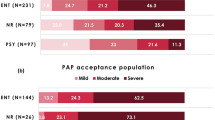Abstract
To define the patterns of referral of adult patients with obstructive sleep apnea syndrome (OSAS) for diagnostic sleep testing, we studied 97 consecutive patients with OSAS (Apnea/Hypopnea Index ≥ 20) referred to the Center for Sleep and Ventilatory Disorders, an American Sleep Disorders Association-accredited university sleep center. Chart review and semi-structured patient telephone interview quantified the time between the onset of any major feature of OSAS and referral to the sleep center, as well as the time between the first OSAS complaint to a health care provider and referral to the center. The average time elapsed between first recognition by the patient of a major feature of OSAS to sleep center referral was 87.5 months (range, 1 to 480 months). Only 4% of referrals were made as a result of the clinician eliciting a history of sleep-related complaints. Once OSAS-related features were apparent to the clinician, the average time to referral for diagnostic testing was 7.9 months (range, 0 to 128 months). These data suggest that both a lack of reporting of symptoms by OSAS patients and a lack of obtaining appropriate sleep history by health care providers contribute to a significant delay in diagnosis of OSA.
Similar content being viewed by others
References
Young T, Palta M, Dempsey J, Skatrud J, Weber S, Badr S.The occurrence of sleep-disordered breathing among middle-aged adults. N Engl J Med 1993;328:1230–1235
Partinen M, Guilleminault C. Daytime sleepiness and vascular morbidity at seven-year follow-up in obstructive sleep apnea patients. Chest 1990;97:27–32
Hung J, Whitford EG, Parsons EW, Hillman DR. Association of sleep apnoea with myocardial infarction in men. Lancet 1990: 336;261–264
He J, Kryger MH, Zorick FJ, Conway W, Roth T. Mortality and apnea index in obstructive sleep apnea: experience in 385 male patients. Chest 1988;94:9–14
Ringler J, Basner RC, Shannon R, et al. Hypoxemia alone does not explain blood pressure elevations after obstructive apneas. J Appl Physiol 1990;69:2143–2148
Podszus T, Greenberg H, Scharf S. Influence of sleep state and sleep-disordered breathing on cardiovascular function. In: Suanders NA and Sullivan CE, eds. Sleep and Breathing, 2nd ed. New York: Marcel Dekker; 1994
Partinen M, Jamieson A, Guilleminault C. Long-term outcome for obstructive sleep apnea syndrome patients. Mortality. Chest 1988;94:1200–1204
Lavie P, Herer P, Peled R, Berger I, Yoffe N, Zomer J, Rubin AE. Mortality in sleep apnea patients: A multivariate analysis of risk factors. Sleep 1995;18;149–157
Dement WC, Mitler MM. It’s time to wake up to the importance of sleep disorders. JAMA 1993;269:1548–1550
Findley LJ, Unverzagt ME, Suratt PM. Automobile accidents involving patients with obstructive sleep apnea. Am Rev Respir Dis 1998;138:337–340
Young T, Evans L, Finn L, Palta M. Estimation of the clinically diagnosed proportion of sleep apnea syndrome in middle-aged men and women. Sleep 1997;20:705–706
National Commission on Sleep Disorders Research report. Vol. 1. Executive summary and executive report. Bethesda, Md.: National Institutes of Health, 93
Rosen RC, Rosekind M, Rosevear C, Cole WE, Dement WC. Physician education in sleep and sleep disorders: A national survey of U.S. medical schools. Sleep 1993;16:249–254
Haponik EF, Frye AW, Richards B, et al. Sleep history is neglected diagnostic information. J Gen Intern Med 1996;11: 759–761
Rubenstein I, Daughton DM, Rennard SI. Physician reporting of and referral for patient complaints about sleep disorders. South Med J 1996;89:483–486
Ball EM, Simon RD Jr, Tall AA, Banks MB, Nino-Murica G, Dement WC. Diagnosis and treatment of sleep apnea within the community: The Walla Walla project. Arch Intern Med 1997;157:419–424
Phillipson EA, Remmers JE (chairs). Indications and standards for cardiopulmonary sleep studies. American Thoracic Society Concensus Conference. Am Rev Respir Dis 1989;139:559–568
Altman DG (ed.). Relationship between several variables. In: Practical Statistics For Medical Research. Chapman and Hall, London, 1991
Fletcher EC, DeBehnkne RD, Lovoi MS, et al. Undiagnosed sleep apnea among patients with essential hypertension. Ann Intern Med 1985; 103:190–194
Viner S, Szalai JP, Hoffstein V. Are history and physical examination a good screening test for sleep apnea? Ann Intern Med 1991;115:356–359
Barsh LI. Responsibilities of the dental profession in recognizing and treating sleep breathing disorders. Compend Contin Educ Dent 1996;17:490–494
Rhode P, Lewinsohn PM, Seeley JR. Comparability of telephone and face-to-face interviews in assessing axis I and II disorders. Am J Psychiatry 1997;154:1593–1598
Krantzler NJ, Mullen BJ, Schutz HG, Grivetti LE, Holden CA, Meiselman HL. Validity of telephoned diet recalls and records for assessment of individual food intake. Am J Clin Nutr 1982;36:1234–1242
Hunter DJ, Manson JE, Colditz GA, et al. Reproducibility of oral contraceptive histories and validity of hormone composition reported in a cohort of US women. Contraception 1997;56: 373–378
Rye DB, Dihenia B, Weissman JD, Epstein CM, Bliwise DL. Presentation of narcolepsy after 40. Neurology 1998;50: 459–465
Author information
Authors and Affiliations
Corresponding author
Rights and permissions
About this article
Cite this article
Rahaghi, F., Basner, R.C. Delayed Diagnosis of Obstructive Sleep Apnea: Don’t Ask, Don’t Tell. Sleep Breath 3, 119–124 (1999). https://doi.org/10.1007/s11325-999-0119-z
Issue Date:
DOI: https://doi.org/10.1007/s11325-999-0119-z




